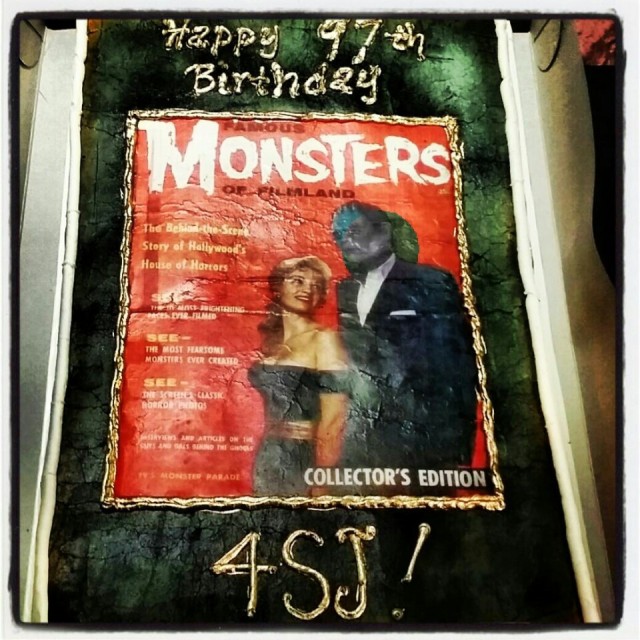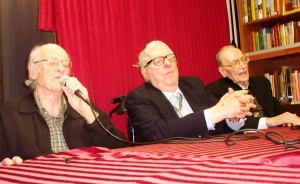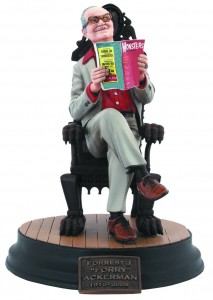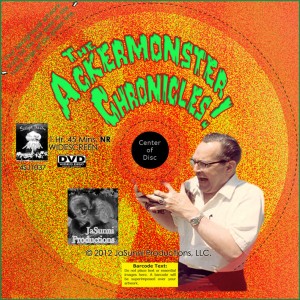John King Tarpinian says, “Of 4E’s passing 5 years ago today one should go to House of Pies and have his usual: fried chicken, spaghetti and a chocolate shake. Two friends went and did that at lunch.”
Tag Archives: Forrest J Ackerman
Forry’s 97th Birthday Cake
Ackermonster Chronicles World Premiere
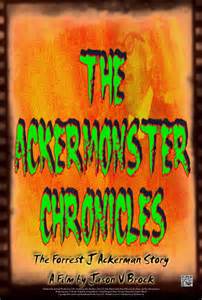 By John King Tarpinian: This Sunday the 24th would have been Forrest J Ackerman’s 97th birthday. The Aero Theater in Santa Monica will be hosting a birthday party for 4E and also premiering the documentary The Ackermonster Chronicles at 5 p.m.
By John King Tarpinian: This Sunday the 24th would have been Forrest J Ackerman’s 97th birthday. The Aero Theater in Santa Monica will be hosting a birthday party for 4E and also premiering the documentary The Ackermonster Chronicles at 5 p.m.
There will be a discussion following the showing with Chris Alexander (Editor-in-Chief of Fangoria Magazine; moderator), George Clayton Johnson (Star Trek, Twilight Zone), William F. Nolan (Logan’s Run), Diane O’Bannon (wife of the late filmmaker/writer Dan O’Bannon [Alien]), Jason V Brock (Director/Writer/Producer), Sunni K Brock (Editor/Producer), and Bill Warren (Ackerman’s assistant and film historian).
Forry Tapping at His Chamber Door?
 Never mind that Forry disbelieved in any afterlife, Paul Davids’ The Life After Death Project analyzes the strange occurrences that some have interpreted as Famous Monsters founding editor — and one of Paul’s best friends — Forrest J Ackerman reaching out to communicate from beyond the grave.
Never mind that Forry disbelieved in any afterlife, Paul Davids’ The Life After Death Project analyzes the strange occurrences that some have interpreted as Famous Monsters founding editor — and one of Paul’s best friends — Forrest J Ackerman reaching out to communicate from beyond the grave.
Too bad I didn’t have this news before the documentary aired on Syfy tonight but all is not lost — the producer will happily sell you a copy of the DVD. In the meantime, sample this 8-minute intro video:
[Thanks to John King Tarpinian for the story.]
Ray Harryhausen (1920-2013)
Visual effects genius Ray Harryhausen, who brought the fantastic alive using stop-motion animation, died May 7 in London at the age of 92.
Between 1949 and 1981 he created effects for Mighty Joe Young, The Beast from 20,000 Fathoms (partly based on a short story, “The Fog Horn,” by Ray Bradbury), It Came from Beneath the Sea, The Animal World, 20 Million Miles to Earth, The 7th Voyage of Sinbad, The 3 Worlds of Gulliver, Mysterious Island, Jason and the Argonauts, First Men in the Moon, One Million Years B.C., The Valley of Gwangi, The Golden Voyage of Sinbad, Sinbad and the Eye of the Tiger and Clash of the Titans.
Harryhausen’s fascination with special effects began in 1933 when he saw King Kong, the handiwork of pioneering animator Willis O’Brien. (They would eventually work together on Mighty Joe Young). Harryhausen’s devotion to King Kong also led to his lifelong friendships with Forrest J Ackerman and Ray Bradbury. He went to a revival of the movie in the early 1940s and saw some stills on display he wanted to copy. The theater employee he asked was Roy Test Jr., co-founder of the Los Angeles Science Fantasy League, who knew the owner of the photos, Forry Ackerman and put them in touch.
Six decades later, as part of the British Film Institute’s celebration of Harryhausen’s 90th birthday, Ray Bradbury described on video their first meeting at Ackerman’s house, when they talked about what they wanted to do with their lives, Harryhausen confessing that he wanted to make movies and Bradbury nervously admitting that he wanted to be a writer….
An important part of Harryhausen’s success was his new ideas. The New York Times explains:
The heart of his technique was a process he developed called Dynamation. It involved photographing a miniature — of a dinosaur, say — against a rear-projection screen through a partly masked pane of glass. The masked portion would then be re-exposed to insert foreground elements from the live footage. The effect was to make the creature appear to move in the midst of live action. It could now be seen walking behind a live tree, or viewed in the middle distance over the shoulder of a live actor — effects difficult to achieve before.
As for the famous skeletons in Jason and the Argonauts, Harryhausen wrote in 2003 that:
Each of the model skeletons was about eight to 10 inches high, and six of the seven were made for the sequence. The remaining one was a veteran from The Seventh Voyage of Sinbad, slightly repainted to match the new members of the family. When all the skeletons have manifested themselves to Jason and his men, they are commanded by Acetes to ‘Kill, kill, kill them all,’ and we hear an unearthly scream. What follows is a sequence of which I am very proud. I had three men fighting seven skeletons, and each skeleton had five appendages to move in each separate frame of film. This meant at least 35 animation movements, each synchronised to the actors’ movements. Some days I was producing less than one second of screen time; in the end the whole sequence took a record four and a half months.
His innovations were honored in 1992 with a career Academy Award for technical achievement. At the Oscar ceremony, Tom Hanks told the audience that he thought the greatest movie of all time was not Citizen Kane or Casablanca but Jason and the Argonauts. Which is quite a reversal of fortunes when you consider that Harryhausen’s The 7th Voyage of Sinbad, a 1959 Hugo nominee, lost to No Award.
Science fiction fandom did eventually become more appreciative. Harryhausen was a Worldcon Guest of Honor in 1987 at Brighton. And he was inducted into the Science Fiction Hall of Fame in 2005.
His filmmaking colleagues also found ways to acknowledge him, dropping in references to his name in animated movies, such as Harryhausen’s restaurant in Monsters, Inc., and giving him live cameos in Beverly Hills Cop III (1994, Bar Patron) and Mighty Joe Young (1998, Gentleman at Party).
Harryhausen’s last feature was Clash of the Titans in 1981. A proposed follow-up, Force of the Trojans, never got a green light. He also came to believe that the movie industry had changed for the worse:
The thing that finally persuaded me to quit was that I saw that the nature of the hero was changing. When I was growing up we had heroes such as Cary Grant, Ronald Colman and David Niven, real gentlemen on the screen. Now, all you have is Arnold Schwarzenegger, Sylvester Stallone and all those people who solve problems with their fists. It’s a different world and I sometimes feel I’m not part of it. Say what you like about Hollywood in my time, but they were in the business of happy endings, of escapism. Now, you have to sit through two hours of people dying, you know. Today, everything’s so graphic it’s rather unnerving.
Harryhausen is survived by his wife, Diana Livingstone Bruce, who he married in 1963. Said Bradbury, “He found just the right woman at just the right time, and it worked out terrifically.”
[Thanks to John King Tarpinian for the story.]
Forry Ackerman Inaction Figure
Beethoven probably never got his own action figure either… Not that Forry moves, just the same, Dark Horse Comics’ Forry Ackerman statuette is an instant front-runner for next year’s Rondo Awards in the Best Toy, Model or Collectible category —
Forrest J Ackerman, commonly known to fans as “Forry”, comes to life in this colorful 13″ tall statue. Forry was the creator, editor and principal writer for Famous Monsters of Filmland, a magazine that influenced generations while spreading the love of the horror genre he was also known for his “Ackermansion,” a sprawling house in Los Angeles that held his extensive horror book and memorabilia collection. For fifty years, Forry shared his collection with fans during open-house events. As an agent, writer, editor, and actor, he had far-reaching influence in the science fiction, horror, and fantasy community. The statue includes a nameplate on the base with one of Forry’s most popular nicknames, “Dr. Acula.”
And think how cool it would be if LASFS bought a batch of these to give its Forry Award winners (instead of the nothing they get now.)
[Thanks to John King Tarpinian for the story.]
15 Costumers You Should Know
The International Costumers Guild is posting a series of short video tributes to the pioneers and superstars of convention masquerades
The trailer “15 Costumers You Should Know” credits Forry Ackerman as the “Father of Convention Costuming” – he wore a “futuristicostume” made by Myrtle Douglas at the first Worldcon in 1939. The series will revisit the historic work of fans Kathy Sanders, Bruce & Dana MacDermott, Karen Schaubelt Turner Dick, Animal X, Jacqueline Ward, Janet Wilson Anderson, Deborah K. Jones, Pierre & Sandy Pettinger, Barb Schofield, Adrian Butterfield and Ricky Dick.
See more at the IGC Archives.
Ackermonster Chronicles on Disc
Friends of the late Forry Ackerman might like to know they can own a copy of JaSunni Productions’ Ackermonster Chronicles — see details at the online store.
[Thanks to John King Tarpinian for the story.]
The Ackerman Oeuvre
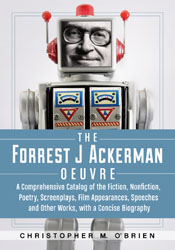 Christopher M. O’Brien’s The Forrest J Ackerman Oeuvre is now available from McFarland.
Christopher M. O’Brien’s The Forrest J Ackerman Oeuvre is now available from McFarland.
For the benefit of those who only know the French they learned from Pepé Le Pew, ouevre means a substantial body of work constituting the lifework of a writer, an artist, or a composer.
A bibliography listing Ackerman’s fiction, nonfiction, poetry, screenplays, film appearances, speeches and other works, plus a filmography and concise biography, fill the book’s 242 pages.
This includes a foreward by Dennis Billows who met Forry at the San Diego Comic-Con around 1975 and spent his free time for the next 20 years organizing his collection. Billows also worked as assistant editor of Ackerman’s magazine, Famous Monsters of Filmland.
O’Brien has spent more than a decade researching the pulp magazines and early science fiction fandom. His fannish credits include an article about William Hamling in Earl Kemp’s eI #55.
[Thanks to Bill Warren for the story.]
Hollywood Underground
When CBS failed to stop ABC from broadcasting a new reality series “The Glass House,” which it called a rip-off of its own “Big Brother,” the network retaliated with a satirical announcement of its plans to develop an imitation of a well-known ABC series to be called “Dancing on the Stars.”
The Washington Post reports:
“Dancing on the Stars” will be broadcast from the celebrity-strewn Hollywood Forever Cemetery, CBS claimed. It will feature “moderately famous and sort of well-known people you almost recognize competing for big prizes by dancing on the graves of some of Hollywood’s most iconic and well-beloved stars of stage and screen.”
The cemetery houses the remains of such Hollywood luminaries as Rudolph Valentino, Cecil B. DeMille, Douglas Fairbanks Sr. and Jr., Tyrone Power and Terry, the dog that played Toto in “The Wizard of Oz.”
If denied its first choice, CBS says “approaches will be made to Westwood Village Memorial Park, where equally scintillating luminaries are interred.”
Westwood Village Memorial Park Cemetery is where Ray Bradbury was laid to rest earlier this month, joining others with strong ties to the sf/fantasy field, Richard Basehart, Robert Bloch, Alexander Courage (composer of the Star Trek theme), and Ray Walston.
The Hollywood Forever Cemetery, in addition to the dog from The Wizard of Oz, is the last resting place of tangential sf/fantasy figures Mel Blanc, Elmo Lincoln (Tarzan in silent movies), Peter Lorre, Darren McGavin, and Fay Wray.
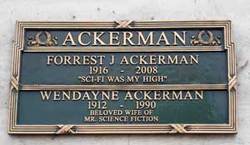
- The Ackerplaque
Forrest J Ackerman, who once speculated about being buried at the Hollywood cemetery with an interactive audio-video plaque, was ultimately interred at Forest Lawn Memorial Park in Glendale with a standard memorial plaque which reads, “Sci-Fi Was My High.” Other notables at Forest Lawn, Glendale with connections to sf/fantasy are James Arness, Joe Barbera (of Hanna-Barbera), L. Frank Baum, Lon Chaney Sr., Walt Disney, Errol Flynn, Fritz Leiber Sr. (the writer’s father), and Jay Ward.
And that’s only scratching the surface…

